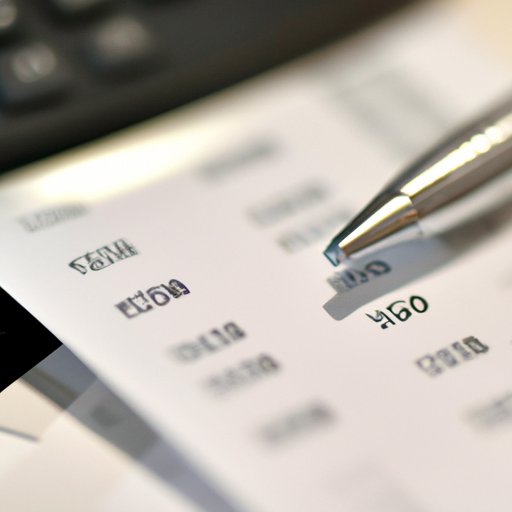
Introduction
Managing your money is a crucial part of adulting, and determining the right amount of money to keep in your checking account is an important decision that many people struggle with. It can sometimes be a challenge, and people often wonder how much is too much or too little. In this article, we’ll dive into the factors that go into deciding on the right amount of money to keep in your checking account.
Start with Your Monthly Expenses
Understanding your monthly expenses is key to figuring out how much money you should keep in your checking account. Begin by adding up all of your recurring expenses, such as rent/mortgage, utilities, and car payments. Once you have a total, subtract it from your monthly income to determine your discretionary income.
After figuring out your discretionary income, create a budget. Your budget should take into account all of your daily expenses such as groceries, gas, entertainment, and other miscellaneous necessities. Once you determine how much money you require per month, you’ll have a better idea of how much money you should keep in your checking account.
Your monthly expenses should serve as the foundation for what you need to keep in your checking account to stay financially afloat.
Determine a Reasonable Buffer
A buffer is money that stays in your checking account to avoid overdrafts and other expenses, and it’s important to have one. What constitutes a reasonable buffer will vary depending on the individual. If you prefer to live close to the edge, then you may opt for a lower buffer, whereas those who want to be on the safe side may go for a larger one.
It’s ideal to have a buffer that covers at least a week’s worth of expenses so that you can avoid panic and hassle. A week’s worth of expenses gives you enough time to transfer money or use a credit card to cover your costs without incurring any extra fees.
Consider Your Income
Your income plays an important role in determining how much money you should keep in your checking account. If you have a steady paycheck, then you may want to keep a buffer of two weeks worth of expenses. If you’re self-employed and receive payments at irregular intervals, then you may prefer to keep a buffer of two months worth of expenses.
It’s essential to make sure that your checking account reflects your spending habits and income level. If you overspend, or if your account cannot sustain your financial realities, then you will find yourself struggling financially.
Plan for Irregular Expenses
Irregular expenses are expenses that don’t occur on a regular basis but can still take a significant toll on your finances. Examples of irregular expenses include car repairs, medical bills, and emergency home repairs.
It can be tricky to plan ahead for irregular expenses, but it’s imperative to do so to avoid financial stress. One way to plan for irregular expenses is to set up a separate savings account and transfer money from your checking account into it. This money can then be used solely for irregular expenses.
Factor in Your Savings Goals
It’s crucial to factor your savings goals into deciding how much money to keep in your checking account. Consider your long-term objectives, such as investing in property, starting a business, or saving for retirement.
One rule of thumb is to try and save at least 20% of your total income, so you may want to set aside 5-10% of that in your checking account. The total amount will ultimately depend on your goal and the timeframe you have to reach it.
Keep in mind that if you can’t afford to save, don’t force it. It’s always better to pay off debt or build your emergency savings account first before thinking about long-term goals.
Automate Your Savings
Automation is a great way to make sure you stay on track with your savings goals. Set up automatic transfers to move money from your checking account into your savings account. This feature can be found in almost every online banking system
Automatic transfers relieve you of the burden of remembering to save money every month, making it easy to stay consistent. Furthermore, if your money is in a savings account, you’ll earn interest on it.
Re-Evaluate Regularly
It’s important to re-evaluate the amount of money you keep in your checking account regularly. Your circumstances may change, and therefore, it’s possible that the amount of money you need to keep on-hand may vary.
Significant life changes such as moving homes, getting married, or having children will likely affect your budget and your checking account. Make sure to adjust your finances accordingly so that you don’t fall into a financial bind.
Conclusion
Figuring out how much money to keep in your checking account is an ongoing process that requires some attention and evaluation. Remember that the right amount of money for your checking account won’t necessarily be the same amount your friends or family have, or even what online sources say.
As you consider how much money to keep in your checking account, be sure to take into account your monthly expenses, your income, your savings goals, and most importantly, your financial priorities. Re-evaluate often, automate where possible, and stay consistent – these steps will help you reach your financial objectives.
Key Takeaways
- Understand your monthly expenses.
- Create a budget for your monthly expenses.
- Determine a buffer for your checking account.
- Remember to plan for irregular expenses.
- Factor in your savings goals.
- Automate your savings.
- Re-evaluate regularly.





